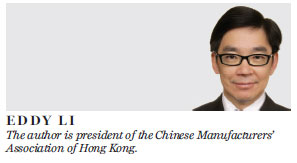Worsening business conditions cloud job market outlook
Updated: 2016-08-15 07:01
By Eddy Li(HK Edition)
|
|||||||||
According to the latest statistics published by the SAR government, the unemployment rate remains at 3.4 percent in Hong Kong, with the underemployment rate staying at 1.4 percent. Although the numbers are identical with last month's figures, they do not mean that all is well in the labor market. Many people in the business community, including me, are not very optimistic about the local employment situation - for there are too many hidden risks.
To have a better grasp of the actual situation facing the labor market, we must first realize there is so-called hysteresis in statistics. (This means that the consequences of something are often experienced with a certain time lag.) For instance, the latest figures are based on data collected from April to June, which have not factored in the summer season: A large number of new graduates have yet to enter the job market. As predicted by Secretary for Labour and Welfare Matthew Cheung Kin-chung, "With the entry of fresh graduates and school-leavers into the labor force during the summer season, the labor supply is likely to be boosted in the coming months." If there are sufficient job vacancies for these new applicants, the unemployment rate will naturally rise.

A recent Hudson survey shows that more than 60 percent of employers intend to freeze their payrolls in the second half of 2016, while 11 percent are inclined to reduce their staff. As a matter of fact, the unemployment rate in some sectors has already triggered concerns. The most obvious ones are for the tourism-related industries: The unemployment rate is 5.6 percent in the retail sector; 4.5 percent in hotels and other accommodation services; and over 5 percent in the catering industry. These three sectors are a barometer of the Hong Kong economy. By simply taking a look at the number of vacant shops, the large discounts being offered by restaurants and the declining occupancy rate of hotel rooms, we can easily see the hardships faced by many businesses.
As noted by some employers in the catering industry, it was just two years ago when almost every restaurant in Hong Kong was fighting for labor resources; yet two years later, although the labor shortage is still bothering them, below-average business conditions have forced them to freeze or even reduce their payrolls to keep their restaurants operating.
Hong Kong's construction industry, media, theme parks and banks have all reported redundancies. Another industry which has had major redundancies is the shipping industry. The last two years have witnessed barely any signs of recovery in global shipping volumes and the sharp decline in freight has only led to a harsher business environment for shipping operators. A hefty 15 percent of the original 60,000 employees in the sector have been dismissed as a result. If the supposed peak season in the remainder of 2016 fails to realize, it's possible another round of redundancies will occur after October. This might seem to be just difficulties facing a single industry, but it really tells us a lot about Hong Kong as an international trade center. The downturn in the shipping industry indicates the overall volume of imports and exports is declining. This suggests many Hong Kong companies are in bad shape.
The University Grants Committee has recently revealed that the unemployment rate for postgraduates of the 2014-15 school year is 4.2 percent, the highest in the past three years and significantly higher than the 1.4 percent in 2013-14. Some human resource consultants have advised recent graduates that being too picky is not helpful in finding a job. I agree. Graduates should understand the difficulties facing many companies. They cannot expect to face too ideal a situation. Being realistic is the key to getting employed.
(HK Edition 08/15/2016 page10)